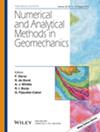Effects of Consolidation Stress and Chemical Compatibility on Contaminant Transport Through Soil‐Bentonite Cutoff Walls
IF 3.4
2区 工程技术
Q2 ENGINEERING, GEOLOGICAL
International Journal for Numerical and Analytical Methods in Geomechanics
Pub Date : 2025-06-25
DOI:10.1002/nag.70003
引用次数: 0
Abstract
The soil‐bentonite (SB) cutoff wall is commonly utilized at contaminated sites to delay the contaminant transport. Current research typically assumes that their transport parameters are constant, ignoring the non‐uniform distribution of these parameters with depth caused by consolidation stress, and performance degradation due to contaminants (i.e., chemical compatibility). A two‐dimensional contaminant transport model was developed in an SB wall system, for the first time, simultaneously considering consolidation stress and chemical compatibility. A computational framework was established to obtain the numerical solution, which was then compared with analytical solutions and centrifuge tests to verify its effectiveness. Subsequently, existing models were compared, and the impact of relevant parameters on SB wall performance was analyzed. The results indicate that neglecting consolidation stress and chemical compatibility can overestimate SB wall performance, with a maximum overestimation of 139.76% for breakthrough time and a maximum underestimation of 96.25% for total flux. The spatial distribution of contaminant source and concentrations of Na固结应力和化学相容性对土壤-膨润土截流墙中污染物运移的影响
土壤-膨润土(SB)防渗墙通常用于污染场地,以延缓污染物的迁移。目前的研究通常假设它们的输运参数是恒定的,忽略了固结应力引起的这些参数随深度的不均匀分布,以及污染物(即化学相容性)导致的性能退化。首次在SB壁体系中建立了同时考虑固结应力和化学相容性的二维污染物输运模型。建立了数值解的计算框架,并与解析解和离心实验进行了比较,验证了数值解的有效性。随后,对现有模型进行了比较,并分析了相关参数对SB墙性能的影响。结果表明,忽略固结应力和化学相容性会高估固相墙的性能,突破时间最大高估139.76%,总通量最大低估96.25%。污染源的空间分布和Na+、Ca2+浓度对突破时间有显著影响。此外,膨润土的含量应在原来的标准上增加,以弥补污染物造成的性能下降。厚度和位置设计应考虑较浅部分的污染源,选择较经济的组合。所提出的模型可以为SB墙的施工提供更全面、准确的指导。
本文章由计算机程序翻译,如有差异,请以英文原文为准。
求助全文
约1分钟内获得全文
求助全文
来源期刊
CiteScore
6.40
自引率
12.50%
发文量
160
审稿时长
9 months
期刊介绍:
The journal welcomes manuscripts that substantially contribute to the understanding of the complex mechanical behaviour of geomaterials (soils, rocks, concrete, ice, snow, and powders), through innovative experimental techniques, and/or through the development of novel numerical or hybrid experimental/numerical modelling concepts in geomechanics. Topics of interest include instabilities and localization, interface and surface phenomena, fracture and failure, multi-physics and other time-dependent phenomena, micromechanics and multi-scale methods, and inverse analysis and stochastic methods. Papers related to energy and environmental issues are particularly welcome. The illustration of the proposed methods and techniques to engineering problems is encouraged. However, manuscripts dealing with applications of existing methods, or proposing incremental improvements to existing methods – in particular marginal extensions of existing analytical solutions or numerical methods – will not be considered for review.

 求助内容:
求助内容: 应助结果提醒方式:
应助结果提醒方式:


